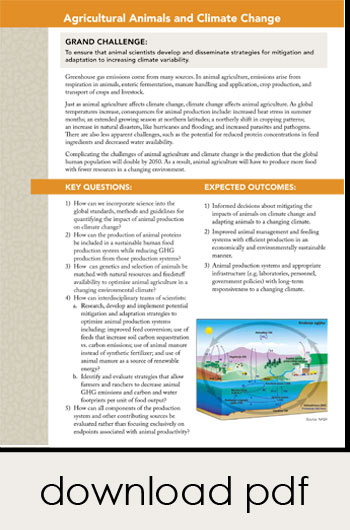Agricultural Animals and Climate Change
Grand Challenge: To ensure that animal scientists develop and disseminate strategies for mitigation and adaptation to increasing climate variability.
 Greenhouse gas emissions come from many sources. In animal agriculture, emissions arise from respiration in animals, enteric fermentation, manure handling and application, crop production, and transport of crops and livestock.
Greenhouse gas emissions come from many sources. In animal agriculture, emissions arise from respiration in animals, enteric fermentation, manure handling and application, crop production, and transport of crops and livestock.
Just as animal agriculture affects climate change, climate change affects animal agriculture. As global temperatures increase, consequences for animal production include: increased heat stress in summer months; an extended growing season at northern latitudes; a northerly shift in cropping patterns; an increase in natural disasters, like hurricanes and flooding; and increased parasites and pathogens. There are also less apparent challenges, such as the potential for reduced protein concentrations in feed ingredients and decreased water availability.
Complicating the challenges of animal agriculture and climate change is the prediction that the global human population will double by 2050. As a result, animal agriculture will have to produce more food with fewer resources in a changing environment.
Key Questions:
- How can we incorporate science into the global standards, methods and guidelines for quantifying the impact of animal production on climate change?
- How can the production of animal proteins be included in a sustainable human food production system while reducing GHG production from those production systems?
- How can genetics and selection of animals be matched with natural resources and feedstuff availability to optimize animal agriculture in a changing environmental climate?
- How can interdisciplinary teams of scientists:
- Research,develop and implement potential mitigation and adaptation strategies to optimize animal production systems including: improved feed conversion; use of feeds that increase soil carbon sequestration vs. carbon emissions; use of animal manure instead of synthetic fertilizer; and use of animal manure as a source of renewable energy?
- Identify and evaluate strategies that allow farmers and ranchers to decrease animal GHG emissions and carbon and water footprints per unit of food output?
- How can all components of the production system and other contributing sources be evaluated rather than focusing exclusively on endpoints associated with animal productivity?
Expected Outcomes:
- Informed decisions about mitigating the impacts of animals on climate change and adapting animals to a changing climate.
- Improved animal management and feeding systems with efficient production in an economically and environmentally sustainable manner.
- Animal production systems and appropriate infrastructure (e.g. laboratories, personnel, government policies) with long-term responsiveness to a changing climate.
Download the Grand Challenges Documents
Read each section:
Animal Health
Agricultural Animals and Climate Change




